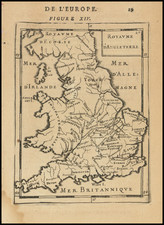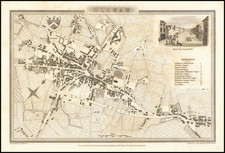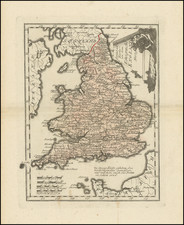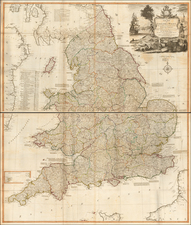Noting Cities With Deputies Sent To Parliament
Nice example of Franz Schraembl's large map of England and Wales, published in Vienna in 1787.
Drawn from the work of Thomas Kitchin, the map provides an exceptionally detailed treatment of England and Wales. Counties are outlined in color, with the map showing towns, roads, rivers, mountains, lakes, islands, and a host of other details.
Title: "Map Key Translation and Summary for the 1787 Map of England"
The key, originally in German, notes:
-
Capital Cities Representation: The capital cities are depicted ichnographically and are engraved in a smaller Roman script.
-
Towns and Market Towns: These are engraved in a script known as Rotunda or Antiqua. In towns sending deputies to Parliament, the town is marked with " * * ".
-
Villages: Marked as 'Doærfer' in the original text.
-
Roads Indication: Parallel lines on the map represent roads.
-
Distance Measurement: Numbers near various locations indicate their distance from London, calculated via the shortest route in miles.
-
Geographic Coordinates: A single line under a place's name denotes latitude, a line with elongated dots signifies longitude, and two lines represent both latitude and longitude. These measurements are based on the observations of members of the Royal Society and the Academy of Sciences, among others.
Schraembl was born and worked in Vienna, where he was a mapmaker in the latter half of the eighteenth century. He began his business in 1787, partnering with Franz Johann Joseph von Reilly. He is best known for his large format atlas, the Allgemeiner Grosser Atlas. The atlas was finished in 1800, after twenty years of compilation and composition--it was the first Austrian world atlas. While a notable work, the atlas did not sell well, plunging Schraembl into financial difficulty. In response, Schraembl expanded his offerings to include literature and art. Upon his death, Schraembl's firm was taken over by his widow, Johanna, and her brother, Karl Robert Schindelmayer. From 1825, it was run by Franz Anton's son, Eduard.













![[ English Historical Broadsheets ] A Table of All The Counties of England and Wales, To Which is added, A Chronology of the Kings of England (with) A Brief History of England, since the Time of Julius Caesar.](https://storage.googleapis.com/raremaps/img/small/103973.jpg)


![[ Southwest England ] Des Koenigreichs England sudlicher Theil oder Cornwall, Devon Shire, Dorset S. Somerset. S. Bristol, Wilt S. Hamp S. Berk. S. Buckingham S. undd Monmouth S.](https://storage.googleapis.com/raremaps/img/small/103898.jpg)